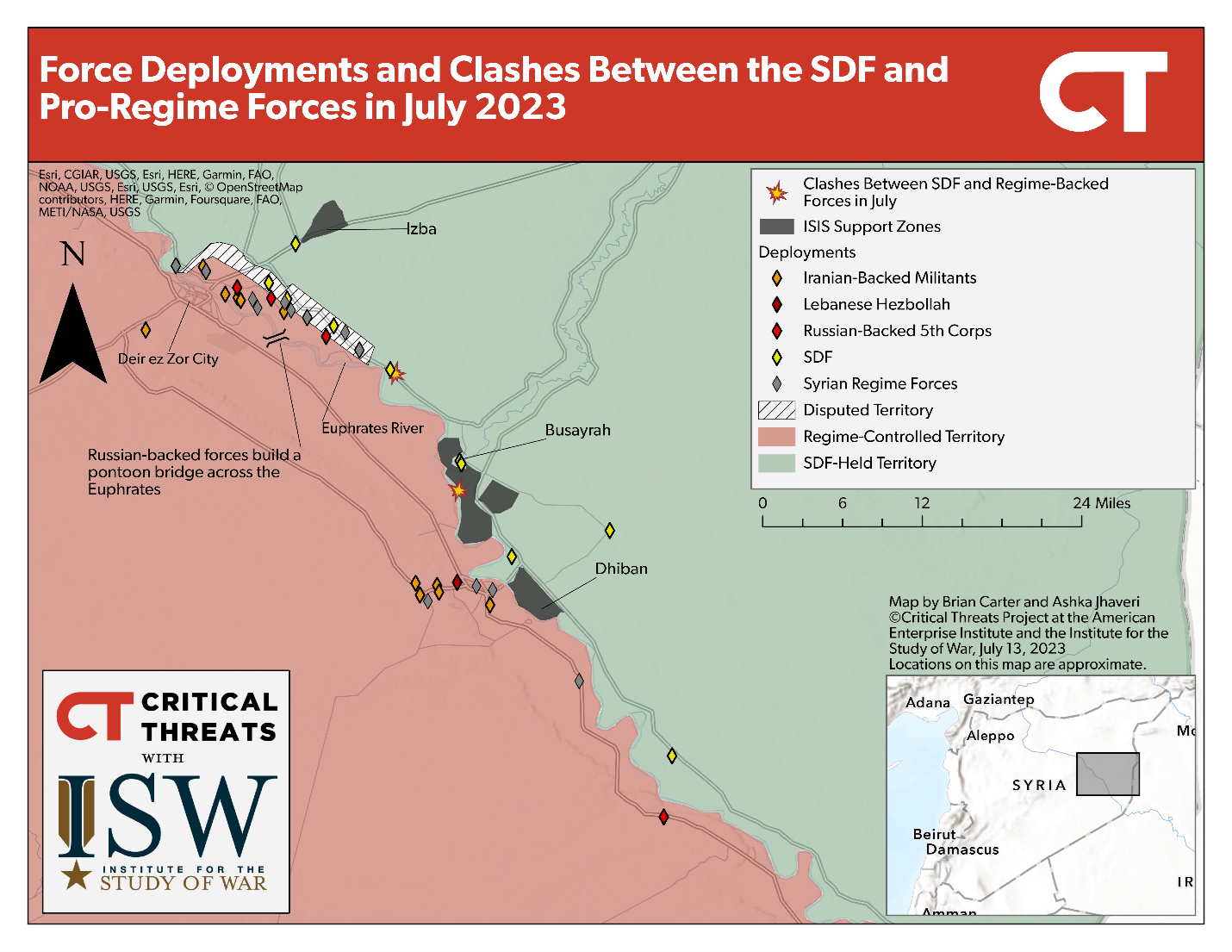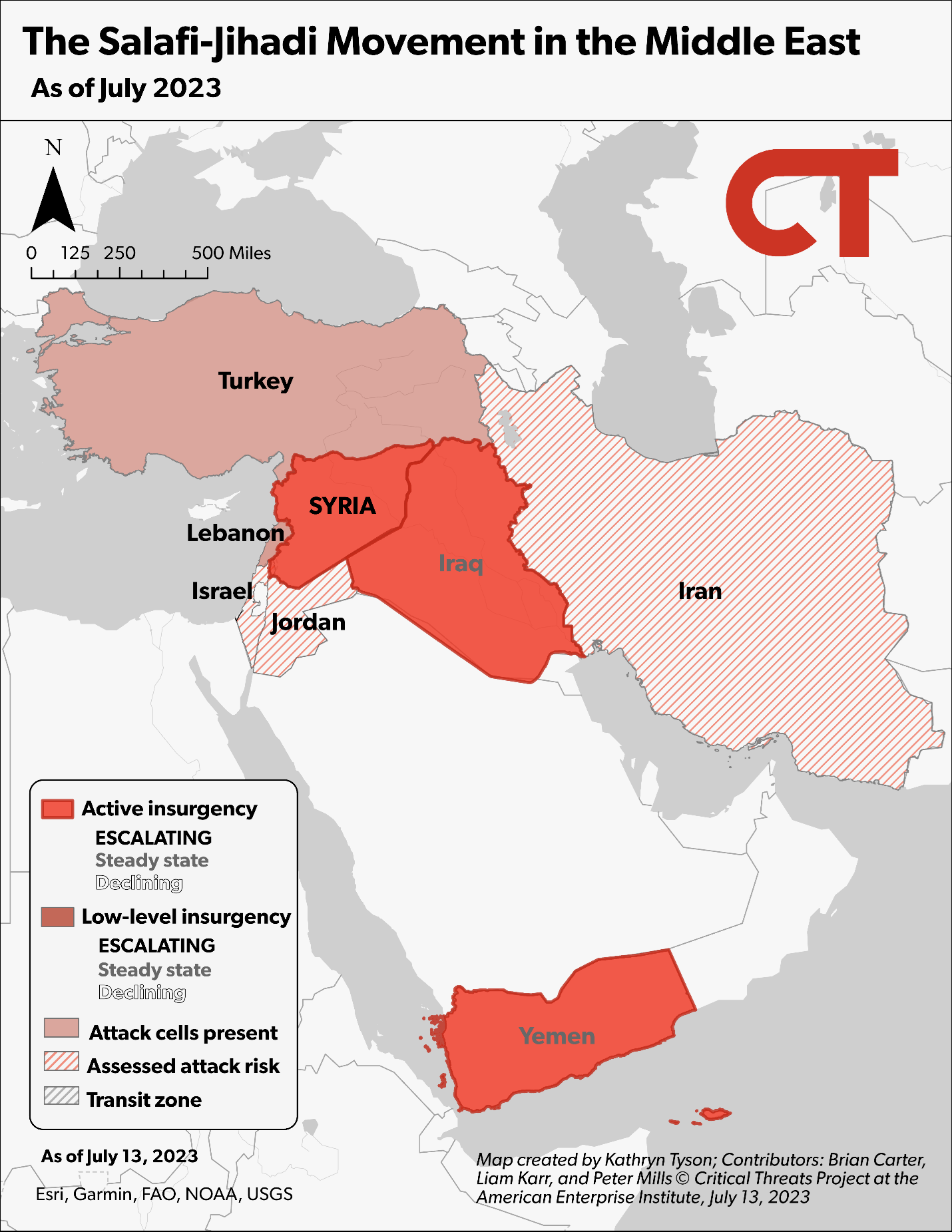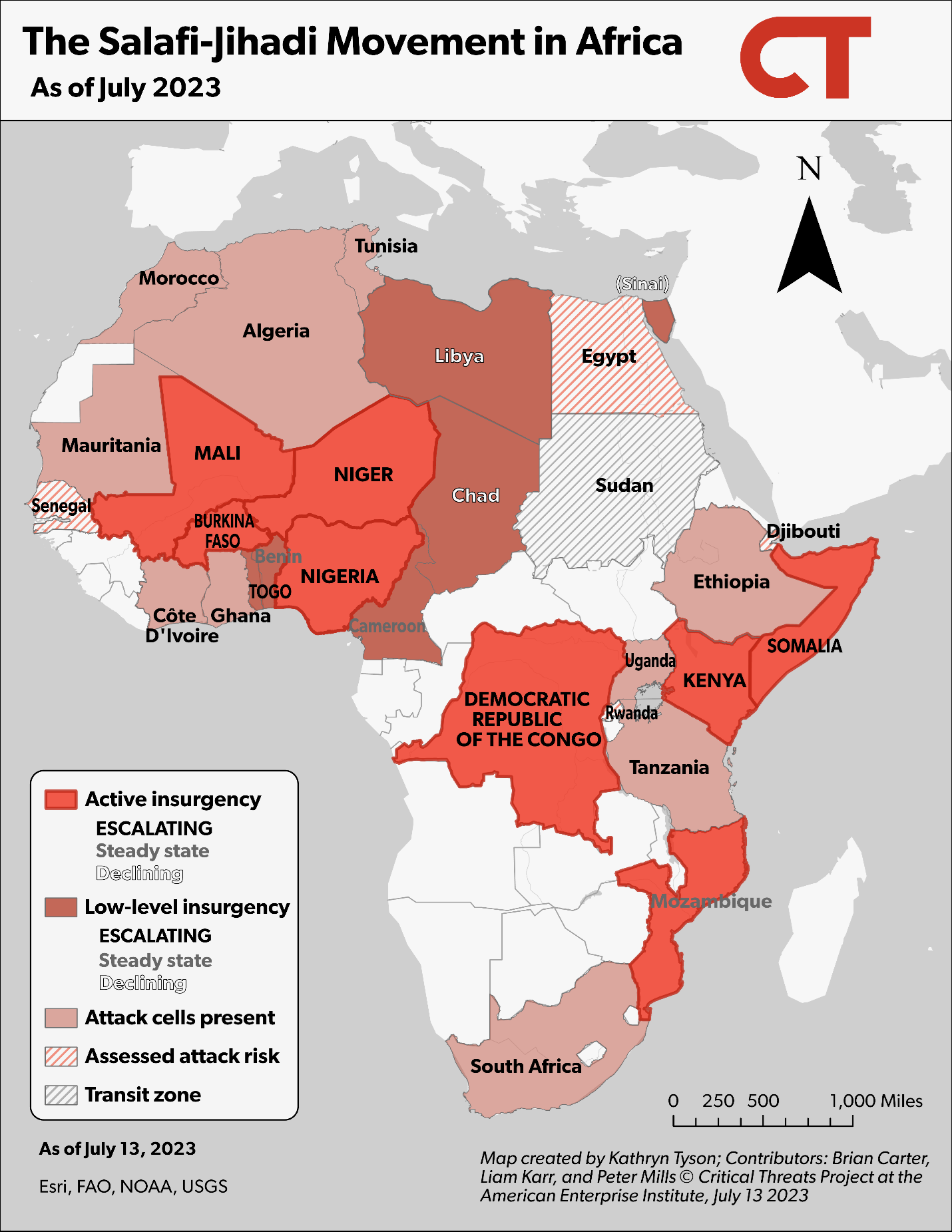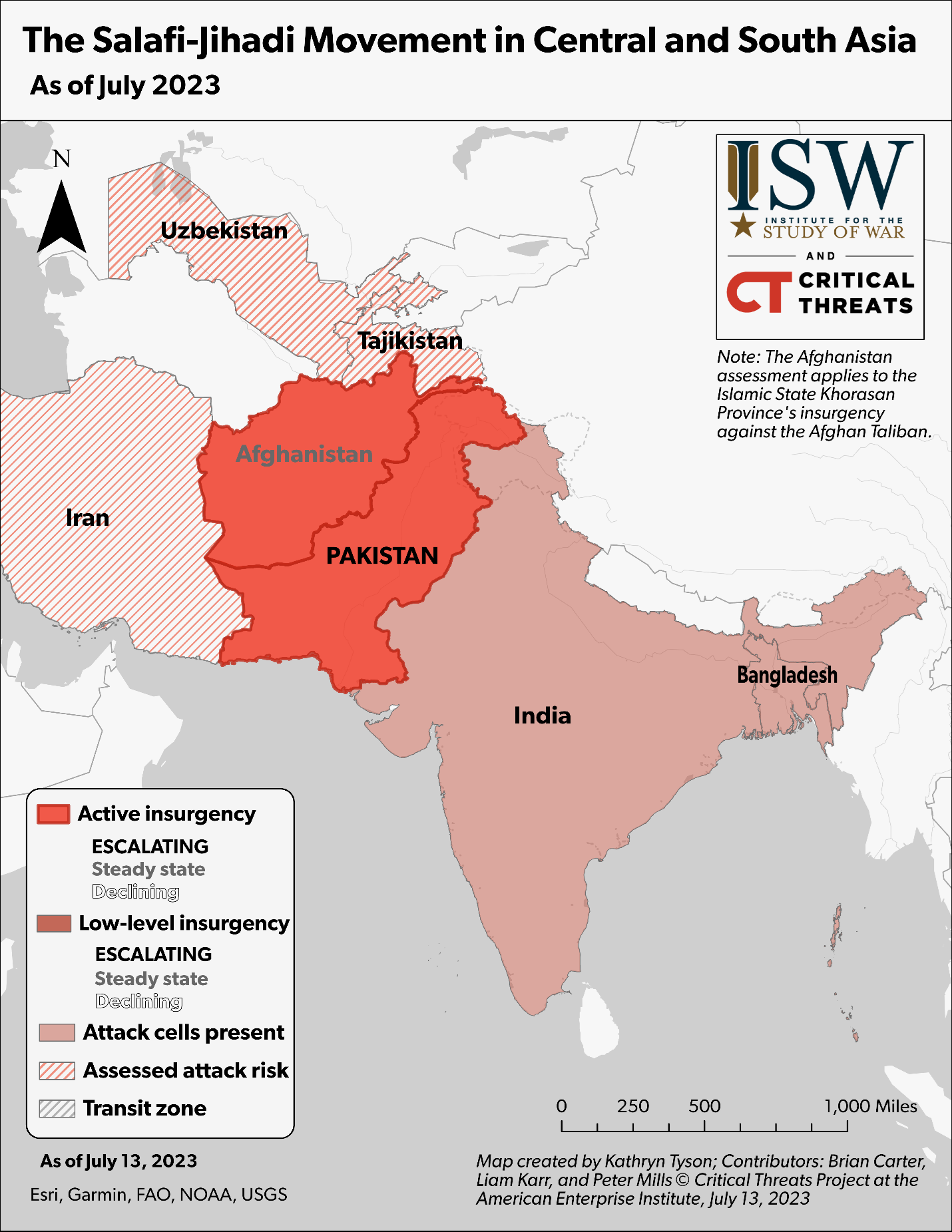 |
 |
Salafi-Jihadi Movement Weekly Update, July 12, 2023

Authors: Brian Carter, Kathryn Tyson, Liam Karr, and Peter Mills
Data Cutoff: July 12, 2023, at 10 a.m.
Key Takeaways:
Iraq and Syria. Iranian, Russian, and Syrian regime deployments and attacks targeting the US-backed Syrian Democratic Forces (SDF) are interfering with an SDF counter-ISIS operation. The operation aims to take advantage of a US drone strike that killed the ISIS governor in Deir ez Zor, which will likely temporarily disrupt the group. Iranian, Russian, Syrian, and ISIS activity illustrates the overlapping threat to the US mission and force in Syria. Each actor seeks to limit US influence in the region and undermine the SDF. A rapid and effective SDF counter-ISIS operation would take advantage of temporary ISIS confusion in the wake of the US drone strike, but regime, Iranian, or Russian-backed harassing attacks could inhibit the SDF’s ability to carry out the operation.
Mali. The erosion of international counterterrorism pressure on Salafi-jihadi insurgents in Mali will likely enable al Qaeda’s regional associate to gradually rebuild transnational attack capabilities in its support zones to conduct external attacks. Al Qaeda–linked militants have historically carried out regional terror attacks and still aspire to build external attack capabilities targeting the West, despite prioritizing their locally focused insurgency in recent years. Jama’at Nusrat al Islam wa al Muslimeen (JNIM) would most likely target Western personnel in Africa or West African partners and could use West African human trafficking networks to target Europe, in the most dangerous scenario. JNIM’s expanding havens in the Sahel will increase the risk of external attacks even if JNIM leadership does not prioritize rebuilding transnational capabilities by giving internationally minded factions or individuals increased opportunities and resources to orchestrate such attacks.
Pakistan. A senior Tehrik-e-Taliban Pakistan (TTP) commander and hundreds of his fighters pledged allegiance to a breakaway TTP faction on July 9, which could draw other TTP militants from his tribe away from the TTP. The commander’s move could be offset by growing coordination between the TTP breakaway faction, the Gul Bahadur group, and the TTP. Greater coordination between the Gul Bahadur group and the TTP may allow the groups to cohere fighters in North and South Waziristan, where both groups have recently been expanding.
Afghanistan. Pakistan is likely expanding security cooperation with Tajikistan to improve its ability to track and target TTP militants in northern Afghanistan. The Taliban government may relocate some TTP militants to northern Afghanistan, but TTP militants will continue to pose a security threat to Pakistan. Intelligence sharing between Pakistan and Tajikistan would allow Pakistan to better track TTP militants in northern Afghanistan near the border with Tajikistan.
Assessments:
Iraq and Syria. Iranian, Russian, and Syrian regime deployments and attacks against the US-backed Syrian Democratic Forces (SDF) are interfering with a US-backed counter-ISIS operation. Iran, Russia, the regime, and ISIS create an overlapping threat to the US mission and force in Syria by conducting separate operations aimed at limiting US influence and undermining the SDF. The SDF deployed large numbers of forces near regime-held territory beginning on July 6 to prepare for a counter-ISIS operation.[1] Both regime- and Iranian-backed forces surged fighters to eastern Deir ez Zor since July 6 and fired small arms and rockets at the SDF on July 10 and 11 in response to SDF counter-ISIS operations.[2] These attacks distract the US-backed SDF from its counter-ISIS operations. The primary US mission in Syria is conducting counter-ISIS operations to cause the enduring defeat of ISIS.
Figure 1. Force Deployments and Clashes Between the SDF and Pro-Regime Forces in July 2023
Source: Brian Carter and the Institute for the Study of War.
Iranian escalation against the United States killed a US contractor in March, which prompted the US mission to assess that US casualties could “impact public opinion, putting the Coalition at risk.”[3] Russian aircraft also conducted an unprofessional intercept of the US drone that targeted the ISIS governor on July 7.[4] CENTCOM has assessed that similar Russian behavior creates a risk of escalation that has the potential to affect the counter-ISIS mission.[5]
The United States killed the Islamic State governor of Deir ez Zor province in a drone strike on July 7, which will likely disrupt coordination between ISIS forces temporarily. This presents an opportunity for the SDF to exploit temporary confusion in a well-timed counterinsurgency operation.[6] The strike will create temporary confusion and a lack of coordination between cells that the SDF could leverage to counter ongoing ISIS lines of effort. The SDF said on July 11 that it conducted a series of counter-ISIS operations in Deir ez Zor province. The SDF conducted these operations in areas CTP assesses ISIS seeks to establish support zones.[7]
Removing key ISIS leadership nodes temporarily inhibits the group’s ability to coordinate or respond rapidly to events until ISIS replaces the previous leader. ISIS in Syria is an extremely siloed organization that requires higher-echelon commanders to coordinate among multiple subordinates to organize responses to anti-ISIS SDF activity or conduct large-scale ISIS offensive operations.[8]
Rapid and effective SDF operations against the group in Deir ez Zor would give the SDF the initiative, allowing it to roll back ISIS presence in certain areas where the group has support.[9] CTP assesses ISIS has support zones in Dhiban, Izba, and near Busayrah, all areas the SDF deployed forces to. A large-scale SDF operation focused on multiple areas simultaneously would force ISIS to make decisions on prioritization of key terrain with no commander or a recently appointed, inexperienced commander. A new commander would struggle to adequately coordinate between ISIS cells while learning to understand and control a highly decentralized command. Delaying such an operation would not take advantage of the removal of the ISIS governor and would provide ISIS time replace him.
The SDF would need to hold any cleared terrain after the operation to create enduring gains against ISIS, however. Without SDF forces remaining to hold the area, an ISIS degraded by a well-timed clearing operation would gradually reenter cleared areas after the operation. The holding phase in counterinsurgency denies the insurgent force the ability to intimidate the population, collect resources, and reenter the area.[10] The holding phase during an SDF operation in this period would also allow the SDF to rebuild local Arab security forces in areas like Dhiban, where ISIS caused the desertion of local SDF forces in 2022.[11]
Figure 2. The Salafi-Jihadi Movement in the Middle East
Source: Kathryn Tyson.
Mali. The erosion of international counterterrorism pressure on Salafi-jihadi insurgents in Mali will likely enable al Qaeda’s regional associate to gradually rebuild external attack capabilities in its support zones to conduct external attacks. The drawdown of international forces since 2022 has caused more proficient counterterrorism forces to vacate areas susceptible to al Qaeda–linked JNIM, which has expanded and consolidated control over parts of northern Mali after the withdrawal of non-UN European troops in 2022.[12] The UN Security Council unanimously voted on June 30 to end its peacekeeping mission in Mali by the end of 2023, which will complete the withdrawal of nearly all international forces from Mali, except the Kremlin-funded Wagner Group.[13] Wagner has not slowed the expansion of Salafi-jihadi groups, and CTP has previously assessed that Wagner’s human rights abuses are almost certainly fueling the insurgency.[14]
Al Qaeda–linked militants in JNIM have carried out regional terror attacks and still aspire to build external attack capabilities targeting the West, despite giving priority to their locally focused insurgency in recent years.[15] JNIM has encouraged external attacks but deprioritized them to focus on local objectives and avoid international retaliation.[16] Some of the group’s leadership has threatened to attack Western partners and European countries in 2023, indicating that at least some of the group’s factions are actively aiming to regenerate transnational capabilities.[17]
JNIM’s growing support zones in northern Mali will almost certainly give it access to the space, resources, and recruitment pools needed to stage regional or international terror attacks. The French withdrawal in 2022 removed effective counterterrorism pressure on JNIM’s support zones and allowed the group unchallenged access to most of rural northern Mali.[18] The departure of UN forces will further strengthen these support zones by allowing JNIM to expand its influence deeper into the urban centers that UN forces secured.[19] CTP previously assessed that the withdrawal of UN forces will also very likely collapse the 2015 peace deal between the Malian government and former rebel groups with ties to JNIM, allowing JNIM to assert itself as the primary power broker and partner for these local actors.[20] The regional Islamic State affiliate has been the main challenger to JNIM in northern Mali since the French withdrawal, but JNIM has used the Islamic State in the Greater Sahara (ISGS) threat to increase ties with local actors as an anti-ISGS protector and recently launched a counteroffensive against the Islamic State affiliate.[21]
JNIM would could target Western personnel in Africa or West African partners with little warning. Regional al Qaeda affiliates have amplified threats to US diplomatic facilitates and personnel despite decreasing attacks on the homeland over the past 10 years.[22] The United States has responded to these threats by restricting US activities in the affected areas, benefiting the Salafi-jihadi groups.[23] This reaction makes attacks in areas such as the Gulf of Guinea countries where the US is increasing efforts to contain the group’s insurgency prime targets.[24] Terror attacks on partner countries also raise the costs of counterterrorism cooperation with the West, weaken faith in Western security cooperation, and undermine Western investment.[25] Al Qaeda–linked militants carried out several high-visibility terror attacks in West Africa throughout the mid-2010s and are active in regional smuggling networks that CTP previously assessed it could use to quickly reactivate these regional capabilities.[26]
JNIM could also send attack cells to Europe via smuggling networks in North or West Africa. JNIM is an affiliate of al Qaeda in the Islamic Maghreb (AQIM), and AQIM is a link between JNIM and al Qaeda senior leaders and a financial and ideological facilitator for JNIM.[27] JNIM and AQIM hold positions along major trafficking routes that run to Europe via northwestern Africa and coastal West Africa.[28] Al Qaeda–linked militants have used smuggling networks to move personnel and assets into North Africa for over a decade but have not used these networks to support operations in coastal West Africa or Europe.[29]
JNIM expanding havens in the Sahel will increase the risk of external attacks, even if its leadership does not give priority to rebuilding transnational attacks over its local insurgency. JNIM has historically focused primarily on its local insurgency over external attacks.[30] Salafi-jihadi groups can shift from being local insurgencies to transnational attack cells due to ideological, bureaucratic, and organizational reasons with little warning.[31] Other al Qaeda–linked groups have opportunistically supported transnational attacks when willing volunteers approach them, even if the groups were not actively plotting attacks.[32] More internationally minded factions within JNIM can also use safe havens to plot transnational attacks, similar to al Qaeda’s relationship with the Taliban.[33]
The Malian junta’s poor relationship with Europe and the 2022 French withdrawal have decreased the deterrent power of international retaliation against JNIM, which may embolden the group to target Europe in a most-dangerous scenario. The Malian junta effectively forced French and UN forces to withdraw from the country after months of preventing them from effectively operating.[34] Low Malian public opinion about Western troops in Mali and decreasing Western public opinion on prolonged deployments in foreign countries further complicate meaningful Western engagement in the future.[35] These factors would limit Western responses to an external attack to the over-the-horizon drone counterterrorism seen in Afghanistan.[36]
Figure 3. The Salafi-Jihadi Movement in Africa
Source: Kathryn Tyson.
Pakistan. A senior Tehrik-e-Taliban Pakistan (TTP) commander and hundreds of his fighters pledged allegiance to a breakaway TTP faction on July 9, which could draw other militants from his tribe away from the TTP.[37] The Gul Bahadur militant group is a TTP breakaway faction based in North Waziristan with strong ties to the Afghan Taliban and Haqqani network.[38] A Pakistan analyst said the TTP denied reports that Mukhlis Mehsud left the TTP, but CTP could not independently verify these reports.[39] Mukhlis Mehsud’s prominence in the organization means other Mehsud militant groups will follow his lead and leave the TTP. Mukhlis Mehsud was a close associate of late TTP leader Hakimullah Mehsud and Hakimullah Mehsud’s factional successor. The Mehsuds form the core of the TTP, and Mehsud leadership has helped reunite splinter TTP groups since 2020.[40]
Mukhlis Mehsud’s move could be offset by growing coordination between the Gul Bahadur group and the TTP. The Gul Bahadur group and the TTP claimed three joint attacks for the first time against Pakistani security forces in North and South Waziristan in June.[41]
The 2021 US withdrawal from Afghanistan may have dampened differences between the Gul Bahadur group and the TTP and enabled renewed cooperation. The Gul Bahadur group split from the TTP in 2007 due to disagreements over attack targets.[42] The leader of the Gul Bahadur group opposed TTP’s attacks against Pakistani forces and instead advocated for attacks on US forces in Afghanistan.
Greater coordination between the Gul Bahadur group and the TTP may allow the groups to cohere fighters in North and South Waziristan, where both groups have recently been expanding.[43] Local sources said the Gul Bahadur group appointed Mukhlis Meshud as the head of the Gul Bahadur groups’ fighters in South Waziristan, a Mehsud heartland. Gul Bahadur has a Waziri tribal base; the Waziri are traditional rivals of the Mehsud tribe.[44] Pakistan announced a possible military operation in North and South Waziristan in April 2023, but a more united fighting force could make the groups more resilient against it.[45] CTP assessed that this operation is currently on hold.[46]
A fracturing of the TTP due to internal differences will hinder Pakistani efforts to negotiate a cease-fire with the resulting splinter groups. The TTP and Pakistan have engaged in intermittent negotiations for years, but talks have ended without agreement.[47] A more divided TTP would mean that Pakistan would have to negotiate with multiple, disparate factions and tribes operating across several regions, complicating the threat environment for Pakistan. The TTP has shown signs of fracturing since January 2023. A TTP faction claimed a major bombing in January that TTP leadership denied.[48] The TTP also dismissed a shadow governor for a province in northwestern Pakistan for claiming an attack that the TTP had denied on July 12.[49] However, the TTP has resolved similar internal conflicts previously.[50]
Afghanistan. Pakistan is seeking to expand military cooperation with Tajikistan, possibly to improve its ability to target TTP militants in northern Afghanistan. Pakistan’s and Tajikistan’s defense ministers met to discuss security cooperation regarding Afghanistan on July 6.[51] CTP previously assessed that the TTP is using Afghanistan to support attacks inside Pakistan, which the Taliban government is failing to prevent.[52] Pakistan’s special representative to Afghanistan said on July 8 that the Taliban government is taking initial steps to address Pakistan’s security concerns and relocate TTP militants away from the border with Pakistan.[53] The Pakistani representative also reaffirmed that Pakistan is not currently seeking negotiations with TTP. Pakistani intelligence cooperation with Tajikistan would give Pakistan access to Tajikistan’s networks in Tajik areas of northern Afghanistan, which would improve its ability to track and target TTP militants moving into northern Afghanistan, near the border with Tajikistan.
The TTP will very likely continue to threaten Pakistan even if some TTP militants are relocated to northern Afghanistan. The Taliban’s enduring relationship with the TTP and refusal to acknowledge the presence of TTP militants in Afghanistan indicate that any security cooperation with Pakistan regarding the TTP will remain limited.[54] The TTP’s freedom of movement in Afghanistan will allow it to continue conducting attacks into Pakistan from bases in northern Afghanistan.[55] CTP previously assessed the Taliban is unlikely to change its policy toward harboring foreign militants.[56]
Sectarian Tensions in Pakistan. Unverified social media reports claimed the TTP and Iran-backed Zainabiyoun Brigade were involved in the sectarian violence between Sunni and Shi’a tribes over disputed lands in the Parachinar area, Kurram District.[57] The Zainabiyoun Brigade is composed of Shi’a Pakistani nationals the Iranian Islamic Revolutionary Guards Corps (IRGC) recruited, trained, and organized to fight in Syria.[58] The brigade recruits from Parachinar and periodically stages pro-Iran demonstrations there.[59]
These sectarian clashes may present an opportunity for the Zainabiyoun Brigade, the TTP, or Islamic State Khorasan Province (ISKP) to recruit locals to their ranks. Greater violence would mobilize the local communities against one another near Parachinar, causing a self-fulfilling cycle of violence and recruitment. CTP has not observed indicators of Zainabiyoun, the TTP, or ISKP attempting to mobilize communities in an organized manner, but the Zainabiyoun has previously recruited from communities affected by sectarian violence. ISKP has not commented or acted on the current clashes, but it has previously operated in Kurram District.[60]
Outbreaks of sectarian violence in Parachinar are common, but jihadist groups in the area use them to build support. The TTP stoked sectarian violence in Kurram in 2009 and used that violence to build support among local Sunni communities by supporting them against their Shi’a rivals.[61] ISKP has exploited sectarian tensions in Pakistan to recruit new members and build alliances with Lashkar-e Jhangvi, a Salafi-jihadi terrorist group.[62] ISKP has explicitly justified its war against religious minorities in Afghanistan and Pakistan as revenge for the Zainabiyoun Brigade’s actions in Syria.[63] ISKP can use an increased IRGC-backed Shi’a militia presence in Pakistan to support its propaganda efforts, justify attacks on religious minorities, and expand recruitment.
Figure 4. The Salafi-Jihadi Movement in Central and South Asia
Source: Kathryn Tyson.
[1] https://sdf-press dot com/?p=40138
[2] https://twitter.com/DeirEzzor24/status/1678535706644234242?s=20; https:...
[3] https://www.dodig.mil/Reports/Lead-Inspector-General-Reports/Article/338...
[4] https://www.centcom.mil/MEDIA/NEWS-ARTICLES/News-Article-View/Article/34...
[5] https://www.dodig.mil/Reports/Lead-Inspector-General-Reports/Article/338...
[6] https://twitter.com/RAEDELHAMID/status/1677355256319991808; https://www...
[7] https://sdf-press dot com/?p=40138; https://www.criticalthreats.org/analysis/salafi-jihadi-movement-update-s...
[8] https://www.crisisgroup.org/middle-east-north-africa/east-mediterranean-...
[9] CTP defines support zones as areas where a group is not subject to significant enemy action and can conduct effective logistics and administrative support of forces. CTP adapts its mapping definitions for insurgencies from US military doctrine, including US Army FM 7-100.1 Opposing Force Operations.
[10] https://www.understandingwar.org/sites/default/files/OperationalArt_in_C...
[11] https://www.understandingwar.org/sites/default/files/OperationalArt_in_C...
[12] https://apnews.com/article/africa-france-united-nations-mali-2cc75f283c8...
[13] https://www.reuters.com/world/africa/un-security-council-ends-peacekeepi...
[14] https://www.criticalthreats.org/analysis/salafi-jihadi-movement-special-...
[15] https://www.criticalthreats.org/analysis/salafi-jihadi-movement-weekly-u...
[16] https://www.aei.org/research-products/report/terrorism-tactics-and-trans...
[17] https://africanperceptions dot org/ar/2023/03/%d8%b9%d8%ab%d9%85%d8%a7%d9%86-%d8%a7%d9%84%d9%82%d9%8a%d8%b1%d9%88%d8%a7%d9%86%d9%8a-%d9%84%d8%a7%d9%84%d8%b1%d8%a4%d9%89-%d8%a7%d9%84%d8%a7%d9%81%d8%b1%d9%8a%d9%82%d9%8a%d8%a9-%d8%b3%d9%86; SITE Intelligence Group, “Africa-Focused News Blog Interviews JNIM Official on Group’s Mission and Growing Circle of Operations, Attacks in Benin and Togo,” March 24, 2023, available by subscription at www.siteintelgroup.com
[18] https://www.criticalthreats.org/briefs/africa-file/africa-file-al-qaeda-...
[19] https://www.criticalthreats.org/analysis/salafi-jihadi-movement-weekly-u...
[20] https://www.criticalthreats.org/analysis/salafi-jihadi-movement-weekly-u...
[21] https://www.criticalthreats.org/briefs/africa-file/africa-file-al-qaeda-...
[22] https://www.criticalthreats.org/analysis/us-embassies-should-not-cede-sp...
[23] https://themessenger.com/opinion/us-embassies-should-not-cede-space-to-t...
[24] https://www.usaid.gov/news-information/press-releases/apr-01-2022-us-str...
[25] https://www.criticalthreats.org/analysis/al-qaedas-growing-threat-to-sen...
[26] https://ctc.westpoint.edu/renewed-jihadi-terror-threat-mauritania; http...
[27] https://www.criticalthreats.org/analysis/the-state-of-al-qaeda-and-isis-...
[28] https://globalinitiative.net/analysis/human-smuggling-trafficking-ecosys...
[29] https://www.airuniversity.af.edu/JIPA/Display/Article/2425320/lassoing-t...
[30] https://www.aei.org/research-products/report/terrorism-tactics-and-trans...
[31] https://www.aei.org/research-products/report/the-next-salafi-jihadi-wave...
[32] https://www.aei.org/research-products/report/the-next-salafi-jihadi-wave...
[33] https://archives.fbi.gov/archives/news/testimony/al-qaeda-international;...
[34] https://www.criticalthreats.org/analysis/salafi-jihadi-movement-weekly-u...
[35] https://www.ifop.com/publication/les-francais-et-lintervention-militaire...
[36] https://www.criticalthreats.org/analysis/managing-the-terrorism-threat-w...
[37] https://twitter.com/AfghanAnalyst2/status/1678041588486791168
[38] https://twitter.com/talhaahmad967/status/1444471272491175939
[39] https://twitter.com/Natsecjeff/status/1678428145119109122
[40] https://ctc.westpoint.edu/fixing-cracks-pakistani-talibans-foundation-tt...
[41] https://twitter.com/KhyberScoop/status/1664942838570790912; https://twi...
[42] https://www.aei.org/articles/the-survivalist-of-north-waziristan-hafiz-g...
[43] https://thekhorasandiary.com/2023/06/04/who-is-rallying-behind-the-amalg...
[44] https://www.aei.org/articles/the-survivalist-of-north-waziristan-hafiz-g...
[45] https://twitter.com/SaleemMehsud/status/1645749464336834561
[46] https://www.criticalthreats.org/analysis/salafi-jihadi-movement-weekly-u...
[47] https://www.aljazeera.com/news/2022/11/28/pakistan-taliban-ends-ceasefir...
[48] https://www.criticalthreats.org/analysis/salafi-jihadi-movement-weekly-u...
[49] https://twitter.com/khorasandiary/status/1679160324661080064
[50] https://www.rferl.org/a/pakistan-taliban-ttp-khan-/31488436.html; https...
[51] https://www dot radio dot gov dot pk/04-07-2023/tajik-defence-minister-meets-with-khawaja-asif-to-discuss-security-cooperation ; https://kabulnow dot com/2023/07/pakistans-defence-minister-highlights-shared-security-threats-with-tajikistan-emanating-from-afghanistan
[52] https://www.understandingwar.org/backgrounder/salafi-jihadi-movement-wee...
[53] https://www.voanews.com/a/pakistan-cautiously-lauds-afghan-taliban-s-mov...
[54] https://www dot arabnews dot pk/node/2335066/Pakistan ; https://ctc.westpoint.edu/the-tehrik-i-taliban-pakistan-after-the-taliba...
[55] https://www.mei.edu/publications/pakistan-afghan-taliban-relations-face-...
[56] https://www.understandingwar.org/backgrounder/salafi-jihadi-movement-wee...
[57] https://www dot dawn dot com/news/1763970/death-toll-from-tribal-clashes-in-kps-kurram-rises-to-9; https://twitter.com/shemrez/status/1678341296417652736; https://twitter... https://twitter.com/ShabbirTuri/status/1678842277026996228
[58] https://home.treasury.gov/news/press-releases/sm590; https://www dot arabnews dot com/node/2222866/world
[59] https://twitter.com/sabena_siddiqi/status/1328255022744920064; https://...
[60] https://www.afghanistan-analysts.org/en/reports/war-and-peace/hit-from-m...
[61] https://www.understandingwar.org/sites/default/files/Haqqani_Network_in_...
[62] https://www.crisisgroup.org/327/asia/south-asia/pakistan/new-era-sectari... https://ctc.westpoint.edu/extremism-and-terrorism-trends-in-pakistan-cha...
[63] https://twitter.com/AfghanAnalyst2/status/1594048806907174913; https://...



